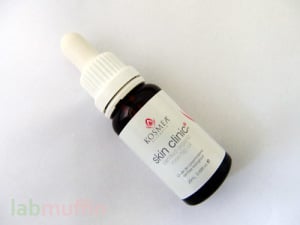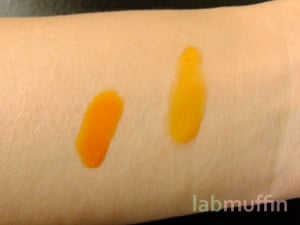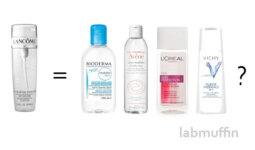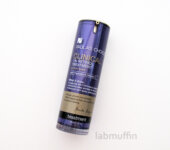Kosmea is an Australian skincare brand that’s still owned and run by an Australian family. I don’t know the whole story of how rose hip oil got so popular, but Kosmea Rose Hip Oil is the only one that claims to be the original rose hip oil, so I’d take their word for it 😉
Unlike most other rose hip oils, Kosmea rose hip oil isn’t South American – it’s sourced from certified organic, hand-picked rosehips from Lesotho in Africa, which supports the local community. The oil is extracted from the whole rose hip (seed, skin, and fruit) using a supercritical CO2 process which doesn’t require heating, which means far less of the unstable nutrients in the oil are destroyed during processing.
(A’kin Rose Hip Oil, which I reviewed earlier, also uses a supercritical CO2 extraction process, but with Chilean rose hips, and the seeds only. In one study, oil from whole rose hip fruit was found to have a higher carotenoid (vitamin A) and tocopherol (vitamin E) concentration. I have no idea whether Kosmea Rose Hip Oil has a higher antioxidant content, or whether this results in an observable difference when used on skin.)
Just like A’kin Rose Hip Oil, this absorbed quickly (maybe a tiny bit quicker) and has left my skin clear and glowing. Kosmea’s (left) is slightly darker than A’kin’s (right), but neither makes my skin noticeably different in colour when rubbed in… perhaps if you’re incredibly white you might see a difference?
Kosmea oil smells slightly stronger than A’kin oil, but the scent disappears after a minute. I don’t find it unpleasant (kind of musty), and it’s easily covered up once I put my moisturiser on over it.
I can’t really tell the difference between the two in terms of their effect on my skin – how do you tell the difference between astounding and breathtaking? I have nothing but praise for both these brands of Rose Hip Oil – all the fangirly gushing I did in the A’kin review equally applies here!
Are there any other brands of Rose Hip Oil you think I should try out?
(Product provided by PR for consideration, which did not affect my opinion of it. Kosmea Rose Hip Oil is available in selected pharmacies and David Jones, or from their website or other e-tailers. RRP AU$24.95 for 20 mL, AU$44.95 for 42 mL.)
V Illés , O Szalai, M Then, H Daood and S Perneczki. Extraction of hiprose fruit by supercritical CO2 and propane. J Supercritical Fluids 1997, 10, 209.








I’ve seen the Kosmea rosehip oil around, but don’t actually know what to use it for! Haha
It’s basically a serum – you rub a few drops into your face just before your moisturiser, or if your skin’s pretty oily, you can skip the moisturiser altogether 🙂
I have just bought the MooGoo brand one, I’d be interested in the reading about the difference in how they are made.
I’ve been emailing rose hip oil companies and trying to work out the key differences between all the oils – some of them are taking a while to get back to me! I didn’t realise MooGoo had a rose hip oil, I’ll email them soon and include them in a round-up (hopefully) soon!
I have been using rose hip oil for years. It’s worked wonders on my acne scarring! The Kosmea….. it is THE best I’ve found!
It’s evening out my skin amazingly as well! 🙂 I need to try out more rose hip oils before I pick a favourite, but I’m really happy with Kosmea and A’kin so far!
There are a lot of less expensive rosehip oils for sale. Do you think that the price difference (the expensive ones are something 4x as much) is worth it? Some also add extra vitamin E etc. What is your opinion of that?
Extra vitamin E – I don’t think it’s necessary, unrefined rosehip oil already has quite a lot in there… I think they’re just cost-cutting.
I’m not sure where you’re from – in Australia, cheap rosehip oil isn’t commonplace as far as I know. Most unrefined (i.e. orangey, rosehip-smelling) rosehip oils extracted using heat-free processes (cold-pressed or CO2 extraction) are in the RRP $15-25 per 20-25 mL price range (A’kin, Kosmea, Sukin, Trilogy). I’ve recently found out (courtesy of Miss Directions above) that MooGoo also sell a slightly cheaper one – $12/20 mL. I think all of them have some sort of organic certification as well.
The one super-cheap rose hip oil I’ve had experience with is one I ordered online – Now Foods rose hip oil, something like $6/30 mL. It’s more refined (colourless and odourless), which takes out a lot of the vitamins and other micronutrients. It still has the fatty acids though. So far it hasn’t been as effective, but I haven’t used it for a long enough time to comment. I’ve heard that some people who have irritation issues with the unrefined stuff prefer the “cleaner” refined rose hip oil though.
Rosehip oil doesn’t contain much vitamin E at all, so buying a rosehip oil with added vitamin E is not bad since vitamin E is a stable antioxidant that not only benefits skin but it also can help extend the shelf life of the oil. Argan oilbis the one that contains a higher amount of vitamin E naturally. I still buy pure rosehip oil on its own, but added vitamin E may be beneficial (especially if you use your oil slowly and want it to be more stable).
I also use pure Rosehip oil for my acne scars and it works great! This helps my scars less visible. Never tried the Kosmea and A’kin brand though.
My scars are fading too! Which brand do you use?
Mmmm very interesting! Love yr research girl xo
Thanks hun! 🙂
This looks pretty neat 🙂 The oil doesn’t stain your skin orange at all? I was always worried that it would, since powdered Vitamin A does for a few days.
Great blog; fun and informative!
I’m not sure if it does since my skin is pretty yellow anyways from the Asian genes 😛 I can’t notice it on my skin, but it might be a problem for pale people. Is the powdered vitamin A applied directly on the face? The closest to a vitamin A measurement I can find is 20-2000 ug carotenoid pigments g-1 extract, depending on extraction technique and whole fruit vs. seed, which I assume is low compared to straight powdered vitamin A.
Thanks! 🙂
Actually I never used it on my face, just on my hands and fingers, and it was dry Vitamin A (50% beta carotene, 50% retinyl palmitate, or thereabouts) mixed in lotion. The oil is a different form (retinol, some other retinoids too? afaik) and is absorbed into your skin fast and you can overdose from it apparently – so it needs to be in measured amounts and I was always afraid to use it straight for any period of time. I sort of wonder how much is in various brands of rosehip oil and how close to daily levels (or above) the Vit A (and E) is.
I used it for a wart* that I got from a hangnail I had (ewww right? sorry… 🙁 nothing else worked on it for 3mos+), but a week and a half of bandage+vitamin A cleared everything up. I got the idea to try topical Vit A after running into a study in the New England Journal of Medicine on skin issues (esp warts & cancers) and topical Vitamin A, which is a billion times more reliable of a source than normal googling yields (“put a banana peel on your face!” etc).
Apparently it’s amazing for acne as well, but I haven’t tried it for that. But, if you need an emergency “zit needs to go now!” pure Vitamin A would probably get results overnight.
I’m as pale as you can be and have had no trouble with rosehip oil (A’kin brand) changing my skin color at all, even put some on the boyfriend and it didn’t change his skin tone at all either. Wonderful stuff.
I’m pale and most rosehip oils like Trilogy, Sukin and Moogoo don’t change the colour of my skin upon application, however Kosmea rosehip oil does add a bit of orange colour to your skin which can stain your pillows if you apply too much or don’t wait for it to absorb so just be cautious of that. It is a good product though, like most other organic rosehip oils.
If you’re looking for another CO2-extracted ones that’s both the seed oil and the fruit extract: I can recommend Pai Organics. Depending where you live, can work out cheaper?
The cheapest version I’ve found is DIY: mixing the seed oil and the fruit extract (CO2-extracted again), getting supplies from Garden of Wisdom.
I’ve also used the unrefined cold-pressed seed oil and the refined seed oil (cheapest found: NOW brand in North America, Mosqueta’s and a few others in the EU). These have lower quantities of vitamins A & E and the other useful stuff.
Most of the rosehip oil around is unrefined cold-pressed seed only, and there’s no point paying more for any brand there, it’s the same stuff. The only tangible difference might be if it’s organic, fair-trade, sustainable and you feel ethically more comfortable buying that–but that’s a very individual choice.
Other differences: some skins are happier with one kind than another; and with many rosehip oils, best to keep them in a cool dark place. Hope that helps vaguely!
That’s interesting! If you broke out from other (stronger) forms of Vitamin A, it could simply be a much larger dosage of Vit A, especially in oil form, causing reactions (pretty common with the liquid form).
Great post on rosehip oil (below) and blog overall (that I hadn’t been to before!). I’m glad that some companies are providing % breakdowns of components in their oils – too many products don’t.
d’oh: another *one*
also, a bit more about the stuff here (with apologies in advance for any out-of-date-ness, inaccuracies, and downright errors): http://gingerrrama.wordpress.com/2011/12/01/review-updated-rosehip-oil/
I’m sure I’ve said this a million times already, but I freaking love your blog.
Agreed re: most of them being very similar in substance, but different people’s skin react differently to different ones. The main points of difference seem to be ethical, and seed only vs. fruit-and-seed. The difference between cold pressing vs. CO2 extraction seems to mainly be yield, not product quality.
Another point of difference is customer service – Kosmea replied in great detail to my email inquiry in under 24 hours but I’m still waiting on A’kin, which automatically makes me somewhat biased towards Kosmea, despite not having any real bearing on product quality 😛
Alas, Australian skincare and cosmetics is usually several times the price of stuff overseas, regardless of how well our dollar is doing, and shipping is always horrific. Not sure if the Pai website is giving Australia-specific or general prices – it’s $36.06/30 mL, which seems to be approximately standard.